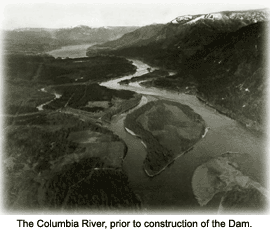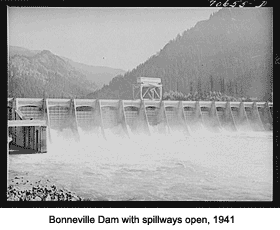Long before Franklin Roosevelt’s New Deal, consideration had been given to developing the economy along the Columbia River by building dams for flood control, irrigation, navigation, and power generation. In 1929, the Army Corps of Engineers prepared a report that recommended 10 dams along the river. No action was taken, however, until the Roosevelt administration.
 In 1934, two huge projects were started: Grand Coulee Dam in north central Washington State and Bonneville Dam, which would span the river between Washington and Oregon at a spot 80 miles upstream from Portland. Construction of the Bonneville Dam began in June 1934, and took three years. The construction drew 3,000 workers, many from relief rolls, who were delighted at the $.50 per hour wage offered ordinary laborers. In addition, the highways and railway lines along the river had to be elevated.
Marketing the electricity was a politically sensitive issue. Roosevelt was determined to keep the dam as a public source of power, but private interests opposed government involvement in what they viewed as private industry. Public power advocates carried the day with the passage of the Bonneville Project Act, which Roosevelt signed on August 20, 1937. Commercial power began to flow from its generators in 1938. The initial wholesale cost of power was $17.50 per kilowatt year, a rate maintained for the next 28 years.
In 1934, two huge projects were started: Grand Coulee Dam in north central Washington State and Bonneville Dam, which would span the river between Washington and Oregon at a spot 80 miles upstream from Portland. Construction of the Bonneville Dam began in June 1934, and took three years. The construction drew 3,000 workers, many from relief rolls, who were delighted at the $.50 per hour wage offered ordinary laborers. In addition, the highways and railway lines along the river had to be elevated.
Marketing the electricity was a politically sensitive issue. Roosevelt was determined to keep the dam as a public source of power, but private interests opposed government involvement in what they viewed as private industry. Public power advocates carried the day with the passage of the Bonneville Project Act, which Roosevelt signed on August 20, 1937. Commercial power began to flow from its generators in 1938. The initial wholesale cost of power was $17.50 per kilowatt year, a rate maintained for the next 28 years.
 The 2,690-foot (820 meters) long and 197-foot (60 meters) high dam was a mixed blessing. For many American Indians who had lived along the Columbia for centuries, the dam was a disaster. The reservoir behind the Bonneville Dam flooded their villages and inundated traditional fishing locations. Migrating salmon also encountered obstacles that were only partially mitigated by fish ladders and other man-made techniques.
Controversy over the pricing of Bonneville`s electric power continues to this day. Pacific Northwest residents view cheap hydroelectric power as their birthright. People in other parts of the country note that Bonneville and the other dams on the Columbia were built with federal money and that if power were sold at "market rates," people across the country would benefit from the additional profits.
The 2,690-foot (820 meters) long and 197-foot (60 meters) high dam was a mixed blessing. For many American Indians who had lived along the Columbia for centuries, the dam was a disaster. The reservoir behind the Bonneville Dam flooded their villages and inundated traditional fishing locations. Migrating salmon also encountered obstacles that were only partially mitigated by fish ladders and other man-made techniques.
Controversy over the pricing of Bonneville`s electric power continues to this day. Pacific Northwest residents view cheap hydroelectric power as their birthright. People in other parts of the country note that Bonneville and the other dams on the Columbia were built with federal money and that if power were sold at "market rates," people across the country would benefit from the additional profits.